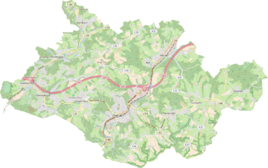Aggerhof
|
Aggerhof
City of Overath
Coordinates: 50 ° 57 '26 " N , 7 ° 18' 53" E
|
||
|---|---|---|
| Height : | 102 m above sea level NN | |
|
Location of Aggerhof in Overath |
||
Aggerhof is a district of Vilkerath in the town of Overath in the Rheinisch-Bergisches Kreis in North Rhine-Westphalia , Germany .
Location and description
The district of Aggerhof, which is primarily populated by small businesses and single houses, is located between Bundesstraße 55 (which is called Kölner Straße here ) and the Siegburg – Olpe railway in the Aggertal . Today the former residential areas Aggerhof, Untervilkerath and Steinhaus have grown together to form a closed settlement area that forms the core of the Vilkerath district, one of the seven districts of Overath.
The next villages are Krombach , Bernsau , Rott and Alemich .
history
The Topographia Ducatus Montani by Erich Philipp Ploennies , Blatt Amt Steinbach , shows that the residential area had a courtyard as early as 1715, which is labeled as Zum Agger . Carl Friedrich von Wiebeking names the court on his charter of the Duchy of Berg in 1789 as Acher . From it it emerges that the place was part of the Honschaft Vilkerath in the parish Overath at that time .
A skirmish between residents of the Aggerhof and French rioters in 1795 resulted in a note in the history books under the keyword Knütteljungenkrieg . In the dispute, an Overath miller's boy by the name of Schwamborn acted as general .
The place is recorded on the topographical survey of the Rhineland from 1817 as Aggerhof . The Prussian first recording from 1845 shows the residential area also under the name Aggerhof . From the Prussian new admission in 1892, the place is regularly recorded as Aggerhof on measuring table sheets .
In 1822, 19 people lived in the place categorized as Hof und Mühle (meaning the Aggermühle ) and designated Acherhof , which after the collapse of the Napoleonic administration and its replacement belonged to the Overath mayor in the Mülheim am Rhein district . For the year 1830 24 inhabitants are given for the place called Acherhof . According to the overview of the government district of Cöln in 1845, the place called Aggerhof and categorized as a hamlet and mill had seven residential buildings with 51 inhabitants at that time, all of them Catholic denominations.
The list of inhabitants and livestock from 1848 gives a little insight into the living conditions of earlier times. It has 45 residents in Aggerhöffgen , including 23 children. There were three farmers with their families and cattle holdings: Christian Abstohs, Johann Fischer and Peter Abstohs. Johann Heuser, Wilhelm Becker and Wilhelm Klein are described as without trade , and they are classified as poor by the authorities . The day laborers Wilhelm Flüch ( poor ) and Heinrich Hoeck were assigned 1 cow and 2 goats , respectively . The carpenter Johann Clever, who had 4 children and 1 goat, was also poor .
The municipality and estate district statistics of the Rhine Province list the place under the name Aggerhöfchen in 1871 with six houses and 46 inhabitants. In the municipality encyclopedia for the Rhineland province of 1888, nine residential buildings with 56 inhabitants are given for Aggerhof . In 1895 the place had seven houses with 47 inhabitants, in 1905 nine houses and 40 inhabitants are given.
Individual evidence
- ^ Wilhelm Fabricius : Explanations for the Historical Atlas of the Rhine Province. Second volume: The map from 1789. Division and development of the territories from 1600 to 1794. Bonn 1898.
- ↑ Jörg Poettgen (editorial): 950 years Overath (1064-2014): street names tell history , p 17 Hrsg.:Bergischer Geschichtsverein Overath, Overath, 2014.
- ↑ Alexander A. Mützell: New topographical-statistical-geographical dictionary of the Prussian state . tape 1 . Karl August Künnel, Halle 1821.
- ↑ Friedrich von Restorff : Topographical-statistical description of the Royal Prussian Rhine Province , Nicolai, Berlin and Stettin 1830
- ↑ Overview of the components and list of all the localities and individually named properties of the government district of Cologne: by districts, mayor's offices and parishes, with information on the number of people and the residential buildings, as well as the Confessions, Jurisdictions, Military and former state conditions. / ed. from the Royal Government of Cologne [Cologne], [1845]
- ^ Berthold Gladbach, Peter Lückerath: The Overather population in lists of names, taxes and residents from the 15th to the 20th century, p. 182. Ed .: Geschichtsverein Rhein-Berg, Bergisch Gladbach 2016. ISBN 978-3-932326-75 -2 , p. 329
- ↑ Royal Statistical Bureau Prussia (ed.): The communities and manor districts of the Prussian state and their population . The Rhine Province, No. XI . Berlin 1874.
- ↑ Königliches Statistisches Bureau (Prussia) (Ed.): Community encyclopedia for the Rhineland Province, based on the materials of the census of December 1, 1885 and other official sources, (Community encyclopedia for the Kingdom of Prussia, Volume XII), Berlin 1888.
- ↑ Königliches Statistisches Bureau (Prussia) (Ed.): Community encyclopedia for the Rhineland Province, based on the materials of the census of December 1, 1895 and other official sources, (Community encyclopedia for the Kingdom of Prussia, Volume XII), Berlin 1897.
- ↑ Königliches Statistisches Bureau (Prussia) (Ed.): Community encyclopedia for the Rhineland Province, based on the materials of the census of December 1, 1905 and other official sources, (Community encyclopedia for the Kingdom of Prussia, Volume XII), Berlin 1909.


